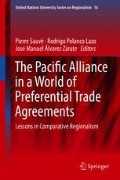Abstract
In a world economy in which Global Value Chains (GVCs) have changed the paradigm of globalisation, we have yet to unravel the implications this has for the architecture of trade and investment agreements. The Pacific Alliance has undertaken to become a platform for more effective insertion into the Asian Pacific and global economy, and has forged new paths in ‘deep integration’ that have delivered results in unconventional ways. This chapter takes stock of some of the achievements and potential limitations of the Pacific Alliance from a Global Value Chain perspective, highlighting the importance of mobility for production factors, market access for sourcing and selling, and physical and digital connectivity as core elements of a GVC-guided integration scheme. Despite the virtues of its open regionalism model, the article questions whether the outward integration of the Pacific Alliance may need to be re-balanced with strengthened inward integration efforts.
The opinions expressed and arguments employed herein are those of the author and do not necessarily reflect the official views of the OECD or of the governments of its member countries.
Access this chapter
Tax calculation will be finalised at checkout
Purchases are for personal use only
Notes
- 1.
The implications of international factor mobility have been addressed in some trade models. As a classical reference, Mundell (1957) introduces international factor mobility and considers it a substitute for international trade in goods and services.
References
Baldwin, R. (2011). 21st century regionalism: Filling the gap between 21st century trade and 20th century trade rules (WTO Staff Working Paper, No. ERSD-2011-08). World Trade Organization.
Baldwin, R., & Lopez-Gonzalez, J. (2013). Supply-chain trade: A portrait of global patterns and several testable hypotheses (NBER Working Papers No. 18957). National Bureau of Economic Research.
Bergstrand, J., & Egger, P. (2010). A general equilibrium theory for estimating gravity equations of bilateral FDI, final goods trade and intermediate goods trade. In S. Brakman & P. Van Bergeijk (Eds.), The gravity model in international trade: Advances and applications. New York: Cambridge University Press.
Blyde, J. S. (Ed.). (2014). Synchronized factories: Latin America and the Caribbean in the era of global value chains. Washington, DC: Springer. https://doi.org/10.1007/978-3-319-09991-0_2.
Curran, L., & Zignago, S. (2012). EU enlargement and the evolution of European production networks. Research in International Business and Finance, 26(2), 240–257.
Damuri, Y. R. (2012). 21st century regionalism and production sharing practice (CTEI Working Papers); online: http://graduateinstitute.ch/files/live/sites/iheid/files/sites/ctei/shared/CTEI/working_papers/CTEI-2012-04.pdf
Horn, H., Mavroidis, P. C., & Sapir, A. (2010). Beyond the WTO? An anatomy of EU and US preferential trade agreements. The World Economy, 33(11), 1565–1588.
Hummels, D., Rapoport, D., & Yi, K.-M. (1998). Vertical specialization and the changing nature of world trade. Federal Reserve Bank of New York Economic.
Lawrence, R. Z. (1996). Regionalism, multilateralism and deeper integration. Brookings, Washington, D.C.
Lejárraga, I. (2017). Regional trade agreements and international production networks. In J. Velut, L. Dalingwater, V. Boullet, & V. Peyronel (Eds.), Understanding mega-free trade agreements. New York: Routledge.
Miroudot, S. (2015). Global production networks in regional trade agreements. In Trade policy implications of global value chains: Case studies. Paris: OECD.
Mundell, R. (1957). International trade and factor mobility. The American Economic Review, 47(3), 321–335 Retrieved from http://www.jstor.org/stable/1811242.
OECD/WTO. (2013). Aid for trade and value chains in Transport and logistics, https://www.oecd.org/dac/aft/AidforTrade_SectorStudy_Transport.pdf
OECD/WTO. (2015). Aid for Trade at a Glance 2015: Reducing Trade Costs for Inclusive, Sustainable Growth. Paris: OECD Publishing. https://doi.org/10.1787/aid_glance-2015-en.
Orecife, G., & Rocha, N. (2014). Deep integration and production networks: An empirical analysis. The World Eocnomy, 37(1), 106–136.
Osnago, A., Rocha, N., & Ruta, M. (2015). Deep trade agreements and vertical FDI: The devil is in the details (Policy Research Working Paper No. WPS 7464). Washington, DC: World Bank Group.
The Heritage Foundation, Index of Economic Freedom, https://www.heritage.org/index/
World Trade Organization (WTO). (2011). World Trade Report 2011. In The WTO and preferential trade agreements: From co-existence to coherence. Geneva: WTO.
Author information
Authors and Affiliations
Corresponding author
Editor information
Editors and Affiliations
Rights and permissions
Copyright information
© 2019 Springer International Publishing AG, part of Springer Nature
About this chapter
Cite this chapter
Lejárraga, I. (2019). The Pacific Alliance As an Instrument for Insertion into Global Value Chains: Lessons from a Progressive and Pragmatic Approach. In: Sauvé, P., Polanco Lazo, R., Álvarez Zárate, J. (eds) The Pacific Alliance in a World of Preferential Trade Agreements. United Nations University Series on Regionalism, vol 16. Springer, Cham. https://doi.org/10.1007/978-3-319-78464-9_4
Download citation
DOI: https://doi.org/10.1007/978-3-319-78464-9_4
Published:
Publisher Name: Springer, Cham
Print ISBN: 978-3-319-78463-2
Online ISBN: 978-3-319-78464-9
eBook Packages: Political Science and International StudiesPolitical Science and International Studies (R0)

